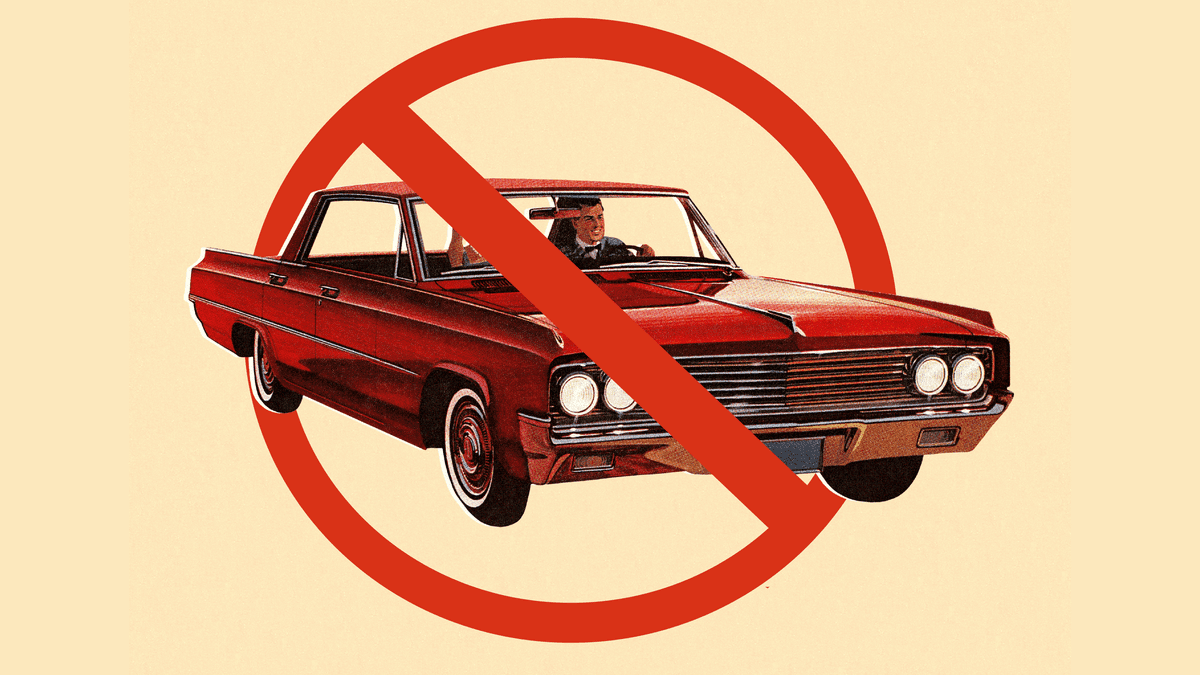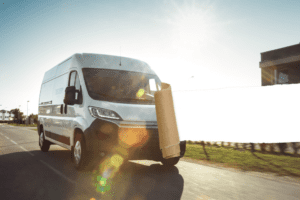What I Mean When I Say 'Ban Cars'

Illustration: Steve DaSilva (Getty Images)
Perhaps you’ve seen the slogan float by on social media. Maybe you’ve spotted it on a sticker on someone’s bike. It has even flashed up on a hacked traffic alert sign:
Ban cars.
Depending on your point of view, this two-word declarative statement is either enticing or alienating, opening up a conversation or shutting it down before it can begin. Some find it perfectly distills the many problems with automobiles; others believe it’s an absurdly reductive position, one that naively ignores the lives and needs of real Americans.
The truth is, outside of some very narrow circles — mainly urbanist scholars and those who pay attention to “bike twitter” — very few everyday people had ever given much thought to the concept of banning cars. That is, until cable news commentators, who process everything through the lens of the culture wars, latched onto it, spinning a niche sentiment into a vague but terrifying threat that someone, somewhere, is conspiring to take away your car and replace it with a bus pass. I promise, that’s not what we talk about at the meetings.
As a two-word summary of a complex movement, “ban cars” is inaccurate and incomplete. Still, there’s no question that many community advocates, urban planners, and policy makers around the planet want to challenge the automobile’s current status at the top of our transportation food chain. Loosely, slightly humorously, and for lack of a better term, we might call this “the ban cars movement,” a name that comes from reappropriating a criticism frequently leveled at those who speak truth to horsepower: “Silly bike people. You’ll never ban cars!”
But what does this movement actually want? Quite simply, “the ban cars movement” wants us to reckon with the truth about the automobile’s impacts on society, to weigh the bad against the good. As Americans, we’ve grown accustomed to ignoring the bad. Last year, 42,915 Americans died in motor vehicle crashes, a 16-year high. Transportation accounts for 27 percent of US carbon emissions. Of that, more than half comes from the vehicles that travel our roads: passenger cars; light-duty pickups, vans, and SUVs; and medium-to-heavy-duty commercial vehicles.
The global demand for ever-larger SUVs “has led to a slackening — or in some cases even reversal — of national rates of fuel consumption improvements,” according to a report by the UN and IEA backed Global Fuel Economy initiative. (If the world’s SUVs were a country, they’d be the sixth-largest carbon emitting nation in the world.) Traffic congestion wastes our time, petrostate dictators and oil company executives steal our income, and cars gobble up an astounding amount of space: There are an estimated eight parking spaces for every car in the US, a geometric fact that no autonomous technology can change. On top of all that, creating space for cars makes building housing more expensive, in a time when nearly every major city in America is enduring a housing crisis. The construction of our interstate highway system worsened racial and economic inequality, contributing to segregation and injustice. It’s hard to think of another consumer product that has so thoroughly reshaped our world, with so much collateral damage.
We keep hearing that EVs are the answer. Electric vehicles will reduce tailpipe emissions, but they won’t solve any of the aforementioned problems — and indeed, they create many of their own. To name just one: Tire wear. It happens no matter what powers a vehicle, and it’s exacerbated by heavier machines. Right now, EVs are massive: the all-electric 6,500-pound Ford F-150 Lightning is 1,000 pounds heavier than its internal-combustion twin. The friction of tires on pavement creates microplastic particles and chemical runoff that pollute oceans, kill salmon and are linked to Alzheimer’s disease and other forms of dementia in humans. It is true that EVs are a necessary part of the fight against climate change, but electric cars are not “good” for the environment — they are only slightly less bad.
No doubt, your car does a lot of good for you and your family. Indeed, in places with no other transport options — in other words, most of North America — a car is a necessity of modern life, like electricity and indoor plumbing. Nobody worth taking seriously is arguing against that, or suggesting it could change tomorrow.
So what’s colloquially known as the “ban cars movement” is not literally a movement to ban cars; it’s an encouragement to question the supremacy of cars in American society. It’s a fight to expand the rights and freedoms of those who are unable to drive — for medical, financial, or legal reasons — and those who are simply uninterested in operating a multi-ton machine where a momentary lapse of judgment can kill. Given the aggregate ways in which cars negatively impact individual lives, communities, and the planet, I believe a good-faith understanding of “the ban cars movement” is actually less radical than maintaining the status quo, which often seems to take the shape of a ban on everything but cars.
I know certain phrases are ripe for misinterpretation. I’m a co-host of a podcast called The War on Cars, after all — a title that comes from another accusation thrown by opponents of bike lanes, busways, or spaces for people to walk: “You’re waging a war on cars!!”
Those folks might dismiss me as an urbanite, detached from everyday America. But it’s precisely that experience — the banal drudgery of the day-to-day car driver — that led me to build my adult life in such a way that I rarely need to drive.
I grew up in a typical suburb where life required a car, shuttled around in my mom’s Buick or driving with friends when I got my license. After college, I lived in car-centric Atlanta. I loved using my car to access Georgia’s lakes and mountains on weekends, and hated it for everything else. My commute to work took 30 minutes on a good day, but good days were rare; an hour, sometimes more, was common. Unpredictability was the only constant.
The quotidian hassle of driving for everything — to earn a paycheck, to maintain a social life, to keep the fridge stocked — felt like a drain on my physical and mental health. Not to mention my wallet. A busted transmission in my used 1994 Subaru Legacy led me to a Hobson’s choice: Either repair the car and wipe out my meager savings all at once, or lock myself into a lease on a new car, wiping out my meager earnings over 36 months. (Reader, I chose the lease.)
I moved to New York City to be closer to my family. A car-free life was a welcome perk. My daily subway commute from Queens to Midtown Manhattan was not without interruptions or delays, but there were more good days than bad. And getting drinks with friends no longer had me worrying about how to get my giant metal box home safely at the end of the night. A few apartments, one marriage and two kids later, I bought a cargo bicycle for errands around the neighborhood, a Citi Bike subscription for my commute to work and a ZipCar membership for the rare moment when I need a motor vehicle.
It’s been nearly 25 years since I last owned a car. I haven’t missed it one bit.
The goal of “the ban cars movement,” as I see it, is not to render cars obsolete. It’s to give people the choice to live a life where car ownership, and car dependence, are unnecessary — regardless of socioeconomic status or physical ability to operate an automobile. It starts in dense urban areas, places where a few policy tweaks could turn public transit, cycling and walking into the lowest-stress, most convenient options.
No societal effort ever reaches 100 percent success. If the humorously-named “ban cars movement” enacted just a fraction of its goals, people who need to drive, or who simply enjoy driving, would still have that option. Car ownership simply wouldn’t be the price of admission for full participation in society. Or for picking up a gallon of milk.
Consider how our society approaches another activity with deep ties to American history, culture, and commerce, one fraught with notions of individual freedom, complicated by how it harms participants and bystanders: smoking. It was once common for people to enjoy cigarettes while flying in an airplane, eating at a family restaurant, or drinking in a bar. As the dangers of cigarettes and exposure to secondhand smoke became clear, smoking was eventually banned in most of these public locations. In 2019, the federal government raised the minimum age to purchase tobacco products from 18 to 21. It’s still possible for American adults to smoke if they choose to — more than 30 million Americans still do, despite the fact that 16 million Americans are currently living with some form of smoking-related disease. In the end, we did not “ban” cigarettes — we simply barred smoking them in certain specific locations and circumstances.
No one drives a cigarette to the grocery store. But what worked to reduce people’s exposure to (and dependence on) cigarettes can offer a useful strategy for doing the same with cars. We’re already seeing the results of this approach. For decades, motorists used the roads running through New York City’s Central Park as a shortcut for daily commuting. Slowly, driving in the park was banned at certain times of day, or on certain days. Eventually, a permanent car ban went into effect in Central Park in 2018, making every visit to the park safer and more peaceful. (The last civilian vehicle to cruise through Central Park was a gorgeous 1966 Mustang.) Similarly, Open Streets programs, which became common in cities around the country during the height of the COVID-19 pandemic, have given people space to spread out and enjoy their communities in new ways, by eliminating automobile traffic. Typically, the worst negative impact from these decisions is a bit of temporary grumbling from drivers, but even that blows over.
None of what I’ve described could be accurately called a “ban on cars.” At worst, you could say these are limits on driving in specific locations and circumstances. Taking a lane away from car traffic to install a protected bike route? Sure, that bans cars — from a sliver of pavement. Dedicated bus lanes do the same. At its heart, “ban cars” is not a call to abolish all motor vehicles, but a focused effort to de-emphasize the least efficient form of transportation — the single-occupancy private vehicle — in urban centers where public transit is available and space is at a premium.
So if “ban cars” doesn’t really mean “ban cars,” why don’t we say what we really mean? Well, “ban cars under specific circumstances and situations” is a bit cumbersome as a hashtag. And while the two-word slogan is a catchy overstatement, it prompts a conversation about the benefits of freeing society from car dependence, at least among those open to the message. In an age of overlapping crises — from the rise in traffic violence to the looming threat of catastrophic climate change — a short, pithy message carries far more impact than a lengthy diatribe.
Who do our public streets and roads belong to? What are they for? These aren’t technical questions to be answered with urban planning and construction proposals — they are fundamentally political questions. Answering them requires the language of social and political movements.
If that seems like a lot for a two-word slogan to accomplish, it is. But we have to start somewhere.
Doug Gordon is a livable streets advocate, the co-host of The War on Cars podcast and a TV producer whose work has appeared on PBS, History, Travel, and more. He has also written for The New Republic, The Guardian and The New York Daily News.




